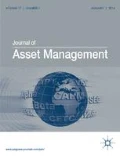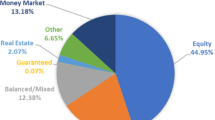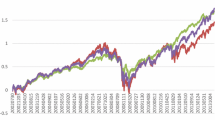Abstract
In this article, I measure and compare the equity and bond market timing ability of hybrid-funds of funds (FOFs) and traditional hybrid funds. Hybrid mutual funds are funds that are invested in a combination of stocks and bonds. Hybrid funds of mutual funds are those that hold shares of other equity and fixed-income mutual funds. This fundamental difference between these two types of hybrid funds makes them an ideal laboratory to examine their stock market timing ability. Using daily fund and index data, I implement a multi-factor timing model, which successfully controls for the fixed-income exposure of hybrids funds. I find that, as a group, hybrid funds failed to correctly time both the equity and bond markets. In addition, I find no difference between the market timing ability of hybrid-FOFs and traditional hybrids.
Similar content being viewed by others
Notes
Some papers look at the hedge funds of funds, for example, Brown et al (2004). Real estate mutual funds are sometimes regarded as funds of mutual funds, as in Chiang et al (2008).
According to data provided by the ICI.
Bertin and Prather (2009) report that their 2003 sample held a median number of 18 funds.
The maturity model was selected instead of the sector model due to data limitations.
For further details, see Livingstone and O’Neal (1998) and O’Neal (1999).
Bollen and Busse (2001) advocate the use of daily fund return data, as high frequency data improves the model power especially when measuring timing ability.
Comer et al (2009) also employ Sharpe style analysis to examine portfolio exposure to the set of factors included in their models.
References
Bär, M., Kempf, A. and Ruenzi, S. (2011) Is a team different from the sum of its parts? Evidence from mutual fund managers. Review of Finance 15 (2): 359–396.
Bertin, W.J. and Prather, L. (2009) Management structure and the performance of funds of mutual funds. Journal of Business Research 62 (12): 1364–1369.
Blake, C.R., Elton, E.J. and Gruber, M.J. (1993) The performance of bond mutual funds. Journal of Business 66 (3): 371–403.
Bollen, N.P. and Busse, J.A. (2001) On the timing ability of mutual fund managers. The Journal of Finance 56 (3): 1075–1094.
Bollen, N.P. and Busse, J.A. (2005) Short-term persistence in mutual fund performance. Review of Financial Studies 18 (2): 569–597.
Brown, S.J., Goetzmann, W.N. and Liang, B. (2004) Fees on fees in funds of funds. Journal of Investment Management 2 (4): 39–56.
Carhart, M.M. (1997) On persistence in mutual fund performance. The Journal of Finance 52 (1): 57–82.
Chiang, K.C., Kozhevnikov, K., Lee, M.L. and Wisen, C.H. (2008) Further evidence on the performance of funds of funds: The case of real estate mutual funds. Real Estate Economics 36 (1): 47–61.
Comer, G. (2006) Hybrid mutual funds and market timing performance. The Journal of Business 79 (2): 771–797.
Comer, G., Larrymore, N. and Rodriguez, J. (2009) Controlling for fixed-income exposure in portfolio evaluation: Evidence from hybrid mutual funds. Review of Financial Studies 22 (2): 481–507.
Fama, E.F. and French, K.R. (1993) Common risk factors in the returns on stocks and bonds. Journal of Financial Economics 33 (1): 3–56.
Fant, L.F. and O’Neal, E.S. (1999) Do you need more than one manager for a given equity style? The Journal of Portfolio Management 25 (4): 68–75.
Glassman, D.A. and Riddick, L.A. (2006) Market timing by global fund managers. Journal of International Money and Finance 25 (7): 1029–1050.
Livingston, M. and O’Neal, E.S. (1998) The cost of mutual fund distribution fees. Journal of Financial Research 21 (2): 205–218.
O’Neal, E.S. (1999) Mutual fund share classes and broker incentives. Financial Analysts Journal 55 (5): 76–87.
Rodríguez, J. (2008) Market timing: A global endeavor. Journal of International Financial Markets, Institutions and Money 18 (5): 545–556.
Sharpe, W.F. (1992) Asset allocation: Management style and performance measurement. The Journal of Portfolio Management 18 (2): 7–19.
Treynor, J. and Mazuy, K. (1966) Can mutual funds outguess the market. Harvard Business Review 44 (4): 131–136.
Wermers, R. (2000) Mutual fund performance: An empirical decomposition into stock‐picking talent, style, transactions costs, and expenses. The Journal of Finance 55 (4): 1655–1703.
Acknowledgements
I thank George Comer for his useful comments and for providing some of the data used in this study. I am grateful for the excellent research assistance of Juan Carlos Cardona. Any remaining errors are the author’s responsibility.
Author information
Authors and Affiliations
Corresponding author
Rights and permissions
About this article
Cite this article
Rodríguez, J. The timing ability of hybrid-funds of funds. J Asset Manag 16, 70–78 (2015). https://doi.org/10.1057/jam.2014.38
Received:
Revised:
Published:
Issue Date:
DOI: https://doi.org/10.1057/jam.2014.38




